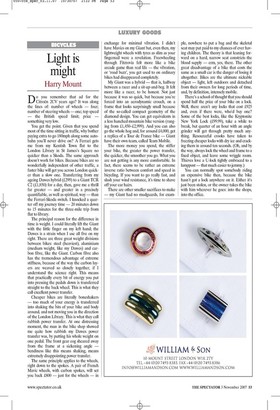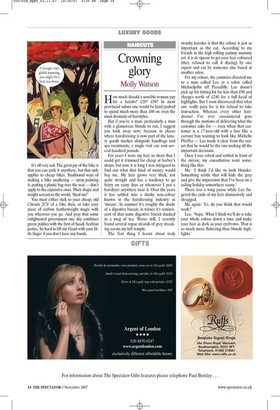Light is might
Harry Mount o you remember that ad for the Citroen 2CV years ago? It was along the lines of: number of wheels — four; number of steering wheels — one; top speed — the British speed limit; price — something very low.
You get the point. Given that you spend most of the time sitting in traffic, why bother paying extra to go 180mph along some autobahn you'll never drive on? A Ferrari gets me from my Kentish Town flat to the London Library in St James's Square no quicker than a Skoda. The same approach doesn't work for bikes. Because bikes are so wonderfully independent of other traffic, a faster bike will get you across London quicker than a slow one. Transferring from my ageing Dawes hybrid (£299) to a Giant TCR C2 (£1,850) for a day, then, gave me a thrill far greater — and greater in a precisely quantifiable, as well as spiritual, way — than the Ferrari-Skoda switch. I knocked a quarter off my journey time — 20 minutes down to 15 minutes for the three-mile trip from flat to library.
The principal reason for the difference in time is weight. I could literally lift the Giant with the little finger on my left hand; the Dawes is a strain when I use all five on my right. There are three great weight divisions between bikes: steel (heaviest), aluminium (medium weight, like my Dawes) and carbon fibre, like the Giant. Carbon fibre also has the tremendous advantage of extreme stiffness, because of the way the carbon layers are weaved so closely together, if I understand the science right. This means that practically every bit of energy you put into pressing the pedals down is transferred straight to the back wheel. This is what they call excellent power transfer.
Cheaper bikes are literally boneshakers — too much of your energy is transferred into shaking the bits of your bike and body around, and not moving you in the direction of the London Library. This is what they call rubbish power transfer. At one distressing moment, the man in the bike shop showed me quite how rubbish my Dawes power transfer was, by putting his whole weight on one pedal. The front gear cog sheared away from the frame at a sickening angle — bendiness like this means shaking, means extremely disappointing power transfer.
The same principle applies to the wheels, right down to the spokes. A pair of French Mavic wheels, with carbon spokes, will set you back £800 — just for the wheels — in exchange for minimal vibration. I didn't have Mavics on my Giant but, even then, my lightweight wheels with tyres as slim as your fingernail were a revelation. Freewheeling through Fitzrovia felt more like a bike arcade game than real life — the vibration, or 'road buzz', you get used to on ordinary bikes had disappeared completely.
My Giant was a hybrid — that is, halfway between a racer and a sit-up-and-beg. It felt more like a racer, to be honest. Not just because it was so quick, but because you're forced into an aerodynamic crouch, on a frame that looks surprisingly small because of the so-called compact geometry of the diamond design. You can get equivalents in a less hunched mountain bike version (ranging from £1,450–£2,999). And you can also go the whole hog and, for around £4,000, get a replica of a Tour de France bike — Giant have their own team, called Team Mobile.
The more money you spend, the stiffer your bike, the greater the power transfer, the quicker, the smoother you go. What you are not getting is any more comfortable. In fact, there seems to be rather an extreme inverse ratio between comfort and speed in bicycling. If you want to go really fast, and slash your wind resistance, it's time to shave off your ear hairs.
There are other smaller sacrifices to make — my Giant had no mudguards, for example, nowhere to put a bag and the skeletal seat may put paid to my chances of ever having children. The theory is that leaning forward on a hard, narrow seat constricts the blood supply — erm, yes, there. The other great disadvantage of a bike that costs the same as a small car is the danger of losing it altogether. Bikes are the ultimate nickable object — light, left outdoors and detached from their owners for long periods of time, and, by definition, intensely mobile.
There's a school of thought that you should spend half the price of your bike on a lock. Well, there aren't any locks that cost £925 and, even if there were, who'd buy one? Some of the best locks, like the Kryptonite New York Lock (£99.99), take a while to break, but quarter of an hour with an angle grinder will get through pretty much anything. Resourceful crooks have taken to freezing cheaper locks with dry ice and cracking them in around ten seconds. (Oh, and by the way, always lock the wheel and frame to a fixed object, and leave some wriggle room. Thieves love a U-lock tightly embraced to a lamppost — that much easier to jemmy.) You can normally spot somebody riding an expensive bike then, because the bike hasn't got a lock anywhere on it. Either it's just been stolen, or the owner takes the bike with him wherever he goes: into the shops, into the office.
It's all very sad. The great joy of the bike is that you can park it anywhere, but that only applies to cheap bikes. Traditional ways of making a bike unalluring — spray-painting it, putting a plastic bag over the seat — don't apply to the expensive ones. Their shape and weight scream to the world, 'Steal me!'
You must either stick to your cheap, old Citroen 2CV of a bike then, or take your piece of carbon featherweight magic with you wherever you go. And pray that some enlightened government one day combines green politics with the best of Saudi Arabian justice. So hard to lift my Giant with your little finger if you don't have any hands.













































































 Previous page
Previous page